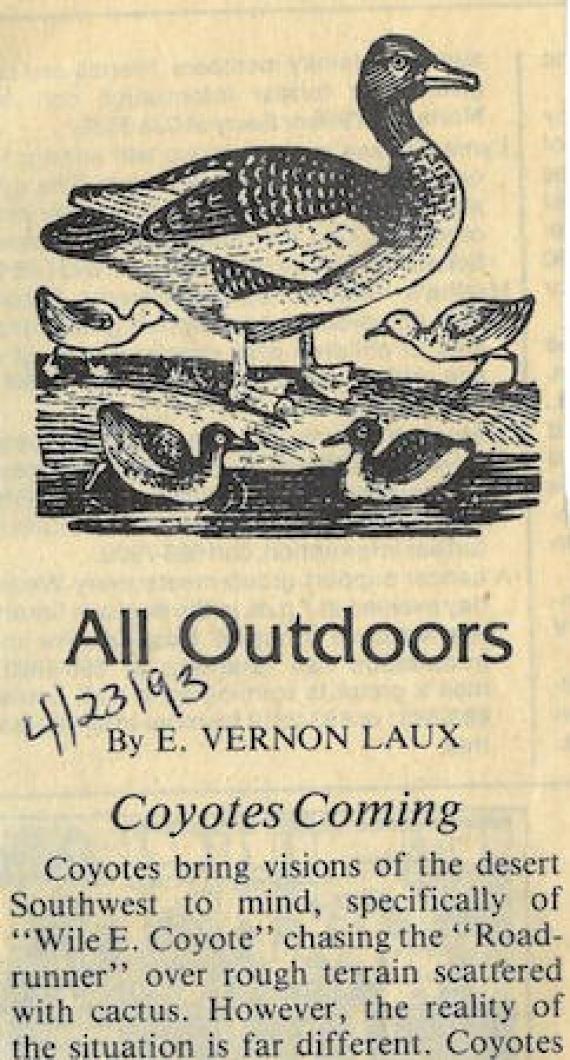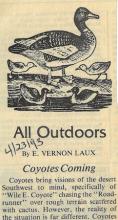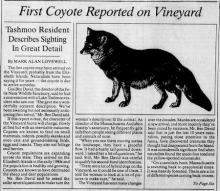Coyotes bring visions of the desert Southwest to mind, specifically of “Wile E. Coyote” chasing the “Road-runner” over rough terrain scattered with cactus. However, the reality of the situation is far different. Coyotes have, in fairly recent times, expanded their range. They are now distributed throughout New York and New England and are spreading southward. In the southern states they are expanding eastward. They are firmly established and regularly seen all over Cape Cod.
Coyotes next swam to the adjacent Elizabeth Islands. Naushon Island in 1986, then all the other. Recently, a Cuttyhunk resident observed a mother with five cubs. Coyotes are strong swimmers. In the Great Lakes they have been observed over five miles from the nearest land. They have been likened on land to a shark in the water. In fact they decimated the wild sheep on the Elizabeths, greatly reduced the white-tailed deer population, and have had quite an impact on local, formerly insulated, wildlife populations.
It is well established that dogs and coyotes mate and produce hybrids that exhibit characteristics of both species. One hears much about “coydogs” in the Northeast. Crosses between the coyote and several of the larger breeds of dogs, notably German shepherds, collies and airedales, have been taken in New York, and presumably other breeds are involved in these mixed populations. Out of more than 200 animals examined in a New York laboratory, only a small percentage indicated a hybrid origin.
The coyote (Canis latrans) looks like an underfed police dog, and typically weighs from 20 to 55 pounds. It has gray or reddish gray fur, with rusty legs, feet and ears. The throat and belly are whitish. The nose is more pointed and the tail is bushier than normal in dogs. The tail is held down between the hind legs when running. Foxes are smaller and hold tails out straight when running.
Coyotes are chiefly nocturnal, but may be abroad at any time. True scavengers, they will eat almost anything animal or vegetable. Their food is predominately small rodents and rabbits. They will cache uneaten food and sometime hunt in pairs. They have a hunting route that is usually about 10 miles, but this may move up to 100 miles or more when food is scarce. They kill large animals by attacking the throat. The home is either a den made by the coyote or a remodeled fox, skunk or badger hole. They often use other shelter. Coyotes have lived for more than 18 years in captivity and can run more than 40 miles per hour for short distances.
In spite of the encroachments of civilization, the adaptive coyote manages to maintain its numbers, and even appears to be increasing in all parts of its range. This is remarkable when we consider how this little prairie wolf has been trapped, hunted, and poisoned for many years, with a price on its heard wherever it occurs. The coyote is an inhabitant of the brush country, but is equally at home in the forests or farm land. In the East, the bark is seldom heard except in heavily forested areas, perhaps because the coyote must make itself less conspicuous in a land where enemies abound.
The coyote is nearby and this writer thinks it’s just a matter of time before one or more swims up on the inviting Vineyard shores so full of food. Man is the only serious enemy of the coyote. With dogs and guns, this little wolf is hunted relentlessly. Few dogs are swift enough to catch him, and the coyote is the equal of any dog of comparable size.









Comments